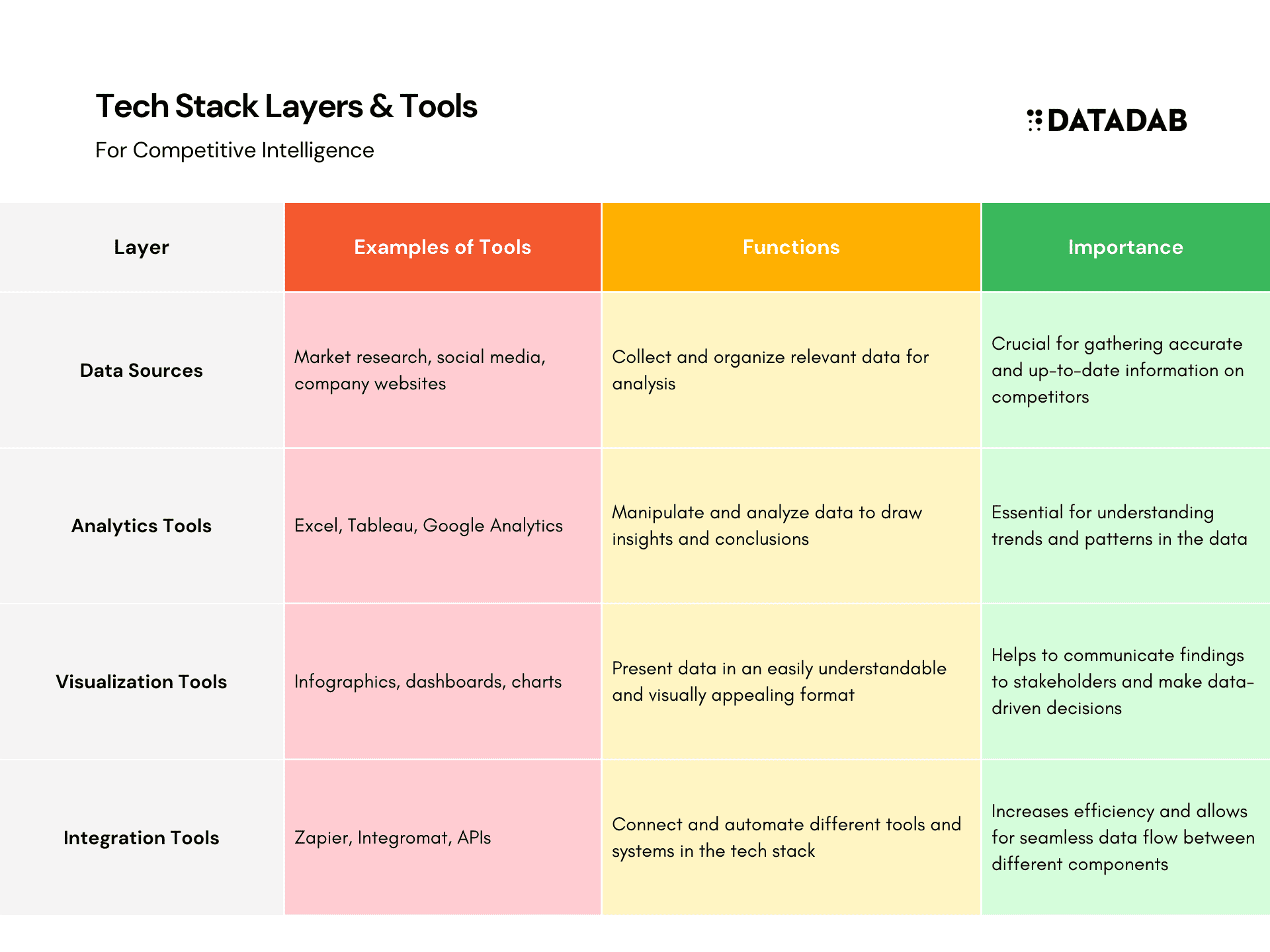As a business owner or manager, staying ahead of the competition is essential for success. This is where competitive intelligence comes in. Competitive intelligence involves gathering, analyzing, and using information about your competitors to gain a competitive advantage.
One way to gather competitive intelligence is through a tech stack. A tech stack is a set of technologies and tools used to build and run a web application. By building a tech stack specifically for competitive intelligence, you can efficiently and effectively gather and analyze data about your competitors.

In this blog post, we will discuss how to build a tech stack for competitive intelligence. We will provide examples and data to support our recommendations.
First, let's define what a tech stack is and why it's important for competitive intelligence. A tech stack is a combination of technologies, tools, and frameworks used to build and run a web application. This can include everything from the programming language and database used to the front-end framework and hosting platform.
Having a tech stack is important for competitive intelligence because it allows you to efficiently and effectively gather and analyze data about your competitors. With the right tech stack, you can automate data collection, perform complex analyses, and visualize the data in a meaningful way. This can help you stay ahead of the competition and make strategic decisions for your business.
Now, let's discuss how to build a tech stack for competitive intelligence.

Identify your goals and objectives
Before building your tech stack, it's important to identify your goals and objectives. What information do you want to gather about your competitors? What do you want to do with that information? How will it help your business?
For example, you might want to gather information on your competitors' products, pricing, marketing strategies, and customer feedback. This can help you understand their strengths and weaknesses, and identify opportunities for your own business.
Once you have identified your goals and objectives, you can begin to select the technologies and tools that will help you achieve them.
Select the right tools and technologies
There are many tools and technologies available for competitive intelligence. Here are some examples:
- Data scraping tools: Data scraping tools allow you to automatically extract data from websites and other online sources. This can be useful for gathering information on your competitors' products, pricing, and marketing strategies. Examples of data scraping tools include Import.io, ParseHub, and Scrapy.
- Natural language processing (NLP) tools: NLP tools allow you to analyze text data, such as customer feedback and social media posts. This can be useful for understanding customer sentiment and identifying trends and patterns in your competitors' customer feedback. Examples of NLP tools include MonkeyLearn, Watson Natural Language Understanding, and Gavagai Explorer.
- Data visualization tools: Data visualization tools allow you to create charts, graphs, and other visualizations of your data. This can help you make sense of complex data and identify trends and patterns. Examples of data visualization tools include Tableau, Power BI, and QlikView.
- Cloud storage and computing platforms: Cloud storage and computing platforms allow you to store and process large amounts of data. This is important for competitive intelligence, as you may need to analyze large datasets to gain insights into your competitors. Examples of cloud storage and computing platforms include Amazon Web Services, Google Cloud Platform, and Microsoft Azure.
Consider the cost and complexity of your tech stack
As you select tools and technologies for your tech stack, it's important to consider the cost and complexity of your stack.
The cost of your tech stack will depend on the tools and technologies you choose. Some tools and technologies are free to use, while others have a cost associated with them. For example, some data scraping tools and NLP tools offer a free version with limited features, while others require a subscription or pay-per-use model.
In addition to the cost, you should also consider the complexity of your tech stack. A complex tech stack can be difficult to manage and maintain and may require specialized expertise to use. This can be a disadvantage, as it can increase the time and resources needed to gather and analyze competitive intelligence.
To balance cost and complexity, you should select tools and technologies that are affordable and easy to use, without sacrificing the capabilities you need.
Test and evaluate your tech stack
Once you have selected the tools and technologies for your tech stack, it's important to test and evaluate your stack to ensure it meets your goals and objectives. This can involve experimenting with different tools and configurations and gathering feedback from team members who will use the stack.
Testing and evaluation can also help you identify any potential challenges or limitations with your tech stack. For example, you may find that a particular tool is not as effective as you thought, or that your tech stack is not scalable to handle large amounts of data. By identifying and addressing these challenges early, you can improve the effectiveness of your tech stack.
Monitor and update your tech stack
Once you have a working tech stack, it's important to monitor and update it regularly. This can involve monitoring the performance and reliability of your stack, and making changes or improvements as needed.
For example, you may need to add new tools or technologies to your stack as your competitive intelligence needs evolve. You may also need to update existing tools and technologies to take advantage of new features or to fix bugs or security vulnerabilities. By regularly monitoring and updating your tech stack, you can ensure it remains effective and efficient.
Building a tech stack for competitive intelligence can help you efficiently and effectively gather and analyze data about your competitors. By following the steps outlined in this blog post, you can build a tech stack that meets your goals and objectives, and helps you stay ahead of the competition.






